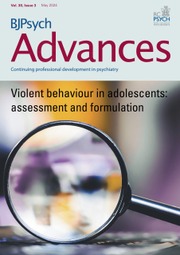No CrossRef data available.
Article contents
Hoarding disorder: overview
Published online by Cambridge University Press: 20 October 2025
Summary
This article presents a narrative review of the literature on hoarding disorder, its aetiology and management. Hoarding disorder is defined by the excessive accumulation of items, leading to living environments that become so cluttered that their functionality and safety are compromised. It is a multifaceted condition that has an impact on both health and social care systems. Some individuals with this disorder show no signs of additional mental health problems, whereas for others, the effects on their mental well-being, their families and the surrounding community can be profound. Given the societal issues that hoarding generates, effective treatment strategies must extend beyond a clinical focus on the individual to encompass a collaborative approach that addresses both the home environment and the potential repercussions for the wider community.
Keywords
Information
- Type
- Article
- Information
- Copyright
- © The Author(s), 2025. Published by Cambridge University Press on behalf of Royal College of Psychiatrists



eLetters
No eLetters have been published for this article.